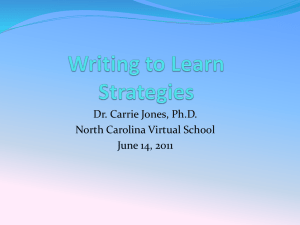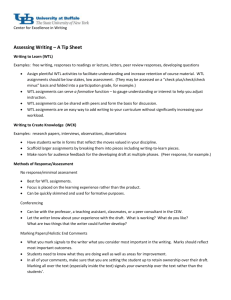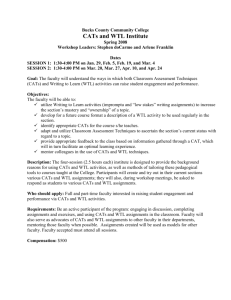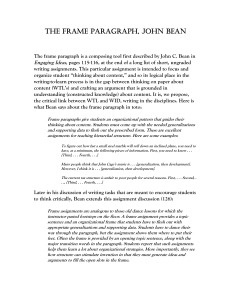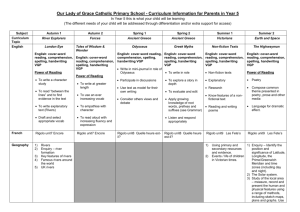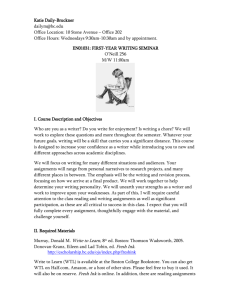Why Writing?
advertisement
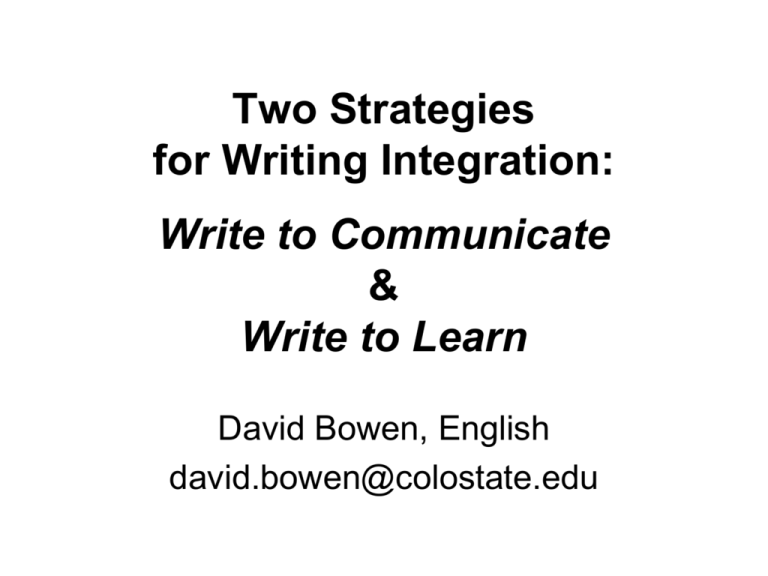
Two Strategies for Writing Integration: Write to Communicate & Write to Learn David Bowen, English david.bowen@colostate.edu CSU Writing Resources • Writing Across the Curriculum http://wac.colostate.edu/intro • The Writing Center (located in Eddy 6) http://writing.colostate.edu/wcenter • Writing@CSU http://writing.colostate.edu • g(uaranteed)t(ransfer)Pathways http://writing.colostate.edu/gtPathways Session Plan 1. Why Writing? 2. Two threads—WTC & WTL 3. WTC—Design and Sequence 4. WTL—Why it’s useful, Design strategies 5. WTL Challenges—mediums, logistics, objections 6. Final Thoughts and Questions Write to Learn Describe how writing has been for you a valuable tool while performing any or all of the following roles: • • • • • Teacher Student Professional Citizen Human being Why Writing? For Teachers: • Writing assignments, both formal and informal, help teachers gauge student progress. • Reflective and evaluative writing provide teachers with a sense of the students’ subjective experience of the course. Why Writing? For Students: • Writing—and its twin, Speaking—is an indispensible mode of communication across disciplines and throughout the broader workplace. • Writing assignments are uniquely suited to help students discover, explore, and retain new ideas. Why Writing? “I know what I think, but I don’t know how to say it.” • Writing is linear; as students move from left to right and top to bottom, writing forces them to choose, qualify, clarify, organize, justify, and ultimately discover exactly what they think. • Writing practice is thinking practice. Why Writing? “Authentic thinking…takes place only in communication.” —Paolo Freire • Writing acts such as evaluating, analyzing, and synthesizing make students active subjects in the learning process, as opposed to passive objects. • Writing acts such as reflecting and responding help students contextualize and relate to new concepts. Two Threads of Writing Integration • Write to Communicate (WTC) — papers, written projects, hard copy or electronic, performative writing, professional genres, multigenre portfolios, individual papers, portfolio compilations — graded with teacher response • Write to Learn (WTL) — in class or online forums, exploratory writing, reflective writing, critical thinking and engagement, preparatory writing, intervention writing, comprehension probes, classroom assessment — “minimal grading” with reader response WTC Product as Learning Process • Sequence major writing assignments using multiple minor writing assignments of graduated difficulty • Breaking major writing tasks into smaller units makes the work both more manageable for students and more valuable to their learning Designing and Teaching the WTC Assignment Cycle Course Objectives Learning Priorities / Hierarchy Multiple Writing Tasks (inside or outside class) Evaluation Criteria Feedback/Response/Comments (from peers or teacher) Revision Priorities or Grade Revised Paper or New Paper Bloom’s Taxonomy • Knowledge: Remembering information • Comprehension: Summarizing information • Application: Using information in new contexts to solve problems • Analysis: Identifying distinct parts and describing relationship between them • Synthesis: Combining previously learned skills and information to generate new, unique whole • Evaluation: Generating and applying criteria in order to produce a value judgment Example WTC Cycle • Quiz—Students remember ideas, developing a critical and disciplinary vocabulary (Knowledge) • Summary—Students describe ideas in their own words, creating a building block for more sophisticated writing assignments (Comprehension) • Response—Students practice applying critical vocab to new contexts, interpreting relationships between and implications of new ideas (Application, Analysis) • Argument—Students locate distinct interpretations of information (research) and combine these to form their own unique interpretation (Synthesis) • Peer Review—Students use stated assignment criteria to offer feedback to their peers (Evaluation) From the Writing@CSU website: http://writing.colostate.edu/guides/teaching/wassign/pop2f.cfm Sample assignment: AG ECON 4XX OVERVIEW: Good analytical writing involves a process of rereading and rewriting, and it is common to do a half dozen or more drafts. Because our understanding of the material will grow throughout the semester, we will complete the assignment in four stages. I will read the drafts produced in each stage and provide comments to aid in your final revision of the completed product. It will be worth one-half of your semester grade. PURPOSE: This project will analyze the peoples and policies related to population, food, and the environment of your chosen country, exploring each of these subsets and highlighting the interrelations among them. Your research and final paper should address the following questions. Population - Explain the dynamic nature of population change in your country or region and the forces underlying the changes. Better papers will go beyond description and analyze the situation at hand: structure of growth, population momentum, rural/urban migration, age structure of population, etc. DUE: WEEK 4. Food - What is the nature of food consumption in your country or region? Is the average daily consumption below recommended levels? What is the income elasticity of demand? Use Engel's law to discuss this behavior. Is production able to stay abreast with demand given these trends? What is the nature of agricultural production: traditional agriculture or green revolution technology? Is the trend in food production… Sample assignment: AG ECON 4XX (Cont.) • • Food (cont.) …towards self-sufficiency? If not, can comparative advantage explain this? DUE: WEEK 8. Environment - Show the environmental impact of agricultural production techniques as well as any direct impacts from population changes. Use the concepts of technological externalities, assimilative capacity, property rights, etc. to explain the nature of this situation in your country or region. What other environmental problems are evident? Discuss the problems and methods for economically measuring environmental degradation. DUE: WEEK 12. Final Draft - The final draft of the project should consider the economic situation of agriculture in your specified country or region from the three perspectives outlined above. Key to such an analysis are the interrelationships of the three perspectives. How does each factor contribute to an overall analysis of the successes and problems in agricultural policy and production of your chosen country or region? The paper may conclude with recommendations, but, at the very least, it should provide a clear summary statement about the challenges facing your country or region. DUE: WEEK15. Write-to-Learn Strategies and ideas to get your students engaged Why Write to Learn (WTL)? • WTL can engage learners just as the iclicker does. Writing may do it better. • WTL can yield essential classroom assessment information. • WTL can get students started on larger projects and offer opportunities to redirect these projects throughout. • WTL can teach students that their ongoing learning matters, not just the end products of their learning. WTL media & logistics • Hard copy in-class or online forum out of class • Simple point system for participation—check, check plus, check minus (3, 4, or 5 points), etc.—culminates in 5% or 10% of semester grade • Collect, read quickly, provide whole-class response. Record participation scores immediately. Do not reward minimal efforts. Dock for absence. Send signal that engagement and participation matter. • John Bean compares grading daily writing to grading scales that a new pianist practices daily before the weekly lesson. Daily work doesn’t receive the same scrutiny as the weekly performance, but does the daily practice matter? You bet! Use WTL to Encourage & Document a Recursive Writing Process • Assignment early stages: – “List three possible research topics posed as inquiry questions” – “Choose one question to exchange with a partner and spend the next three minutes answering his or hers; discuss before sharing with the class” • Assignment mid-stages: – “Describe the most important questions your research seeks to answer and explain how your research so far has addressed them and generated new questions.” This can lead students toward an interpretive problem-thesis structure rather than descriptive “and then, and then” writing – “Two Sentences: Question and Thesis—Write a one-sentence question that summarizes the problem your paper addresses and a one-sentence thesis statement that summarizes your answer to the question.” – “Write an abstract of at least 250 words that distinguishes between the main ideas and supporting ideas of your argument.” A WTL like this clarifies thinking and reveals organizational problems that prompt revision. – Individual 15-minute conferences—required or voluntary based on time, needs, goals, etc. • Assignment final stages: – Peer review—in-class or take-home workshop. Feedback should reflect the evaluation criteria, and should be directed by specific questions or prompts. – Consider assigning a “postscript” that asks students to reflect on the different stages of their writing process, or describe their application of concepts from previous assignments. Use WTL to Motivate and Direct Classroom Discussion & Activities • Write at the start of class to review previous material or launch new concepts • Write to “ramp-up” a group activity or pair work • Write when discussion lags or students seem confused • Write at the end of class to sum up • Record simply as participation as check, check-minus or check-plus. Vary your collection methods: – – – – Student-generated questions for discussion Article main ideas Reading logs and double-entry journals Concept maps for exam prep or general review Designing WTLs that Contribute to Learning • • • • • • • • Assign writing prompts that help students to link course concepts to their personal experiences or prior knowledge. Ask students to explain difficult course material to a new learner. Ask students to generate an imaginary dialogue that questions a hypothetical “expert” about difficult course material. Ask students to describe the relationship between important terms. Give students raw data (such as lists, graphs, or tables) and ask them to summarize, analyze, or evaluate it. Give students a “seed sentence” and ask them to use it to complete a critical response or argument by “growing” the seed sentence into a bigger idea using generalizations and supporting details. Have students role-play unfamiliar points of view, playing “devil’s advocate” or “their side” (vs. my side) in a brief argument. Select an assigned, important article and ask students to write a summary or abstract. Other ideas? The Double-Entry Journal A double-entry journal takes the form of two vertical columns of text, one of which comments on the other. Your journal will place critical reading alongside close reading. In the lefthand column, type the main ideas of the text. When you’re through, print this column of ideas and read them over, recording your own questions and reactions in the righthand column with a pen or pencil. These notes are often very useful for larger projects you’ll do later. This process is a slow-motion version of what your mind does all the time as it interacts with itself in a dialectic fashion, a word derived from the Greek for “art of debate.” Ann Berthoff writes in The Making of Meaning: “The reason for the double-entry format is that it provides a way for the student to conduct that ‘continuing audit of meaning’ that is at the heart of learning to read and write critically.” By writing about your writing, you’ll be thinking about your thinking, and as a result you’ll become a stronger, more deliberate writer and thinker. FINAL THOUGHTS * Might every class begin with the posing of a problem? Might every class end with one? * What discipline-specific questions might your students discover, explore, and answer via writing? * Consider concluding your classes with a WTL for course assessment and development.
